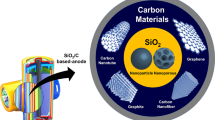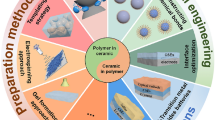Abstract
A hierarchical porous carbon material as the conductive matrix in the sulfur cathode for rechargeable lithium batteries is prepared by an in situ two-step activation method using sucrose as the carbon source, CaCO3 as the template, and (CH3COO)2Cu·H2O (Cu(Ac)2) as the additive. The microstructure and morphology of the activated porous sulfur–carbon composite is characterized by means of X-ray diffraction, N2 adsorption–desorption, and scanning electron microscopy. The functioning mechanism of the additive on the pore formation is investigated using thermogravimetric analysis. Our results establish that thermal decomposition of the nano-CaCO3 template results in the formation of the hierarchical porous carbon structure, and addition of Cu(Ac)2 influences the carbonization process in an un-homogeneous way through the copper ion–sucrose reaction, resulting in the volume increment of small mesopores. The sample obtained shows better sulfur dispersion in the active porous carbon than that synthesized without Cu(Ac)2 involvement, which is attributable to the modified pore structure and enlarged pore volume. Thus, a better utilization of sulfur is achieved and the initial discharge capacity increases from 1,287 to 1,397 mAh g−1. Furthermore, the Li-S battery shows improved cycle stability because of enhanced interaction between the sulfur and the small mesopore.










Similar content being viewed by others
References
Rauh RD, Abraham KM, Pearson GF, Surprenant JK, Brummer SB (1979) A lithium/dissolved sulfur battery with an organic electrolyte. J EIectrochem Soc 126:523–527
Peramunage D, Licht S (1993) A solid sulfur cathode for aqueous batteries. Science 261:1029–1032
Novak P, Muller K, Santhanam KSV, Haas O (1997) Electrochemically active polymers for rechargeable batteries. Chem Rev 97:207–281
Shim J, Striebel KA, Cairns EJ (2002) The lithium/sulfur rechargeable cell–Effects of electrode composition and solvent on cell performance. J Electrochem Soc 149:A1321–A1325
Bai J, Lu B, Bo X, Guo L (2010) Electrochemical property and electroanalytical application of large mesoporous carbons. Electrochem Commun 12:1563–1567
Guo J, Xu Y, Wang C (2011) Sulfur-impregnated disordered carbon nanotubes cathode for lithium–sulfur batteries. Nano Lett 11:4288–4294
Jayaprakash N, Shen J, Moganty SS, Corona A, Archer LA (2011) Porous hollow carbon@sulfur composites for high-power lithium-sulfur batteries. Angew Chem Int Ed 50:5904–5908
Zhang B, Qin X, Li GR, Gao XP (2010) Enhancement of long stability of sulfur cathode by encapsulating sulfur into micropores of carbon spheres. Energy Environ Sci 3:1531–1537
Liang C, Dai S (2006) Synthesis of mesoporous carbon materials via enhanced hydrogen-bonding interaction. J Am Chem Soc 128:5316–5317
Li K, Luo Y, Yu Z, Deng M, Li D, Meng Q (2009) Low temperature fabrication of efficient porous carbon counter electrode for dye-sensitized solar cells. Electrochem Commun 11:1346–1349
Li L, Li LY, Guo XD, Zhong BH, Chen YX, Tang Y (2013) Synthesis and electrochemical performance of sulfur-carbon composite cathode for lithium-sulfur batteries. J Solid State Electrochem 17:115–119
Ding B, Zhang XG, Shen LF, Xu GY, Nie P, Yuan CZ (2013) Encapsulating sulfur into hierarchically ordered porous carbon as a high-performance cathode for lithium-sulfur batteries. Chem Eur J 19:1013–1019
Evers S, Yim T, Nazar LF (2012) Understanding the nature of absorption/adsorption in nanoporous polysulfide sorbents for the Li-S battery. J Phys Chem C 116:19653–19658
Chen S, Zhai Y, Xu G, Jiang Y, Zhao D, Li J, Huang L, Sun S (2011) Ordered mesoporous carbon/sulfur nanocomposite of high performances as cathode for lithium–sulfur battery. Electrochim Acta 56:9549–9555
Ji X, Lee K, Nazar L (2009) A highly ordered nanostructured carbon–sulphur cathode for lithium–sulphur batteries Nat Mater 8:500–506
Lai C, Gao X, Zhang B, Yan T, Zhou Z (2009) Synthesis and electrochemical performance of sulfur-highly porous carbon composites. J Phys Chem C 113:4712–4716
Wang H, Yang Y, Liang Y, Robinson JT, Li Y, Jackson A, Cui Y, Dai H (2011) Graphene-wrapped sulfur particles as a rechargeable lithium–sulfur battery cathode material with high capacity and cycling stability. Nano Lett 11:2644–2647
Ji L, Rao M, Aloni S, Wang L, Cairns EJ, Zhang Y (2011) Porous carbon nanofiber–sulfur composite electrodes for lithium/sulfur cells. Energy Environ Sci 4:5053–5059
Ji L, Rao M, Zheng H, Zhang L, Li Y, Duan W, Guo J, Cairns EJ, Zhang Y (2011) Graphene oxide as a sulfur immobilizer in high performance lithium/sulfur cells. J Am Chem Soc 133:18522–18525
Liang C, Dudney NJ, Howe JY (2009) Hierarchically structured sulfur/carbon nanocomposite material for high-energy lithium battery. Chem Mater 21:4724–4730
Wang D, Zhou G, Li F, Wu K, Lu G, Cheng H, Gentle I (2012) A microporous–mesoporous carbon with graphitic structure for a high-rate stable sulfur cathode in carbonate solvent-based Li–S batteries. Phys Chem Chem Phys 14:8703–8710
Zhao C, Wang W, Yu Z, Zhang H, Wang A, Yang Y (2010) Nano-CaCO3 as template for preparation of disordered large mesoporous carbon with hierarchical porosities. J Mater Chem 20:976–980
Xu B, Wang G, Cao G, Wu F (2010) Easy synthesis of mesoporous carbon using nano-CaCO3. Carbon 48:2377–2380
Zhao C, Wang W, Liu R, Yang Y (2010) LMC/S composite synthesized by vacuum impregnation at normal temperature. Battery 40:6–9
Qiao W, Song Y, Seong-Ho Y, Isao M (2005) Modification of commercial activated carbon through gasification by impregnated metal salts to develop mesoporous structures. New Carbon Mater 20:198–204
Rettig J, Trotter J (1987) Refinement of the structure of orthorhombic sulfur, α-S8. Acta Cryst C43:2260–2262
Gallacrer C, Pinkerton A (1993) A redetermination of monclinic γ-sulfur. Acta Cryst C49:125–126
Sricharoenchaikul V, Pechyen C, Aht-ong D, Atong D (2008) Preparation and characterization of activated carbon from the pyrolysis of physic nut (Jatropha curcas L.) waste. Energy Fuel 22:31–37
Peng H, Xiao H, Yin HQ (2008) Effect of CO2 activation on preparation of honeycomb carbon and its performance. Resource Development Market 24:673–703
Liang X, Liu Y, Wen Z, Huang L, Wang X, Zhang H (2011) A nano-structured and highly ordered polypyrrole-sulfur cathode for lithium–sulfur batteries. J Power Sources 196:6951–6955
He M, Yuan L, Zhang W, Hu X, Huang Y (2011) Enhanced cyclability for sulfur cathode achieved by a water-soluble binder. J Phys Chem C 115:15703–15709
Marmorstein D, Yu T, Striebel K, McLarnon F, Hou J, Cairns E (2000) Electrochemical performance of lithium-sulfur cells with three different polymer electrolytes. J Power Sources 89:219–226
Cheon S, Choi S, Han J, Choi Y, Jung B, Lim H (2004) Capacity fading mechanisms on cycling a high-capacity secondary sulfur cathode. J Electrochem Soc 151:A2067–A2073
Acknowledgments
This work was supported by the National Natural Science Foundation of China (51202242) and the Knowledge Innovation Program of Chinese Academy of Sciences (no. S201124).
Author information
Authors and Affiliations
Corresponding author
Rights and permissions
About this article
Cite this article
Wang, M., Zhang, H., Zhang, Y. et al. A modified hierarchical porous carbon for lithium/sulfur batteries with improved capacity and cycling stability. J Solid State Electrochem 17, 2243–2250 (2013). https://doi.org/10.1007/s10008-013-2096-1
Received:
Revised:
Accepted:
Published:
Issue Date:
DOI: https://doi.org/10.1007/s10008-013-2096-1




